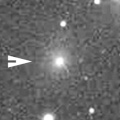
|
Now it is 9.8 mag (July 6, Ken-ichi Kadota). It will fade out rapidly after this. It will be unobservable soon in the Northern Hemisphere, or in October in the Southern Hemisphere. But it will be observable again in July. It is somewhat fainter than this ephemeris recently.
Date(TT) R.A. (2000) Decl. Delta r Elong. m1 Best Time(A, h)
July 8 23 31.92 -37 34.4 0.715 1.520 121 8.6 3:08 (343, 15)
July 15 22 8.74 -49 44.9 0.579 1.502 138 8.1 2:45 ( 0, 6)
|
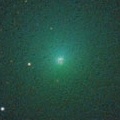
|
It brightened very rapidly. Now it is 9.3 mag (July 7, Carlos Labordena). It will fade out rapidly after this. In the Northern Hemisphere, it stays observable in good condition. In the Southern Hemisphere, it is not observable now, but it will appear in August.
Date(TT) R.A. (2000) Decl. Delta r Elong. m1 Best Time(A, h)
July 8 16 14.76 80 42.2 0.603 1.033 74 9.2 21:16 (180, 44)
July 15 18 9.84 79 43.9 0.555 1.052 77 9.2 22:44 (180, 45)
|

|
Now it is 10.5 mag (July 6, Ken-ichi Kadota). It stays 10 mag for a while. In the Northern Hemisphere, it will be getting higher gradually. In the Southern Hemisphere, it stays observable in good condition.
Date(TT) R.A. (2000) Decl. Delta r Elong. m1 Best Time(A, h)
July 8 3 11.36 13 12.3 2.738 2.334 56 9.9 3:08 (267, 19)
July 15 3 12.40 11 12.4 2.632 2.359 63 9.8 3:13 (273, 25)
|

|
It brightened up to 8 mag from 2022 summer to 2023 spring. Now it is 10.8 mag (June 10, Chris Wyatt). It stays 12 mag for a while. In the Northern Hemisphere, it is not observable now, but it will appear in August. In the Southern Hemisphere, it will be getting higher gradually.
Date(TT) R.A. (2000) Decl. Delta r Elong. m1 Best Time(A, h)
July 8 6 6.90 -10 48.9 3.777 3.019 36 11.3 3:08 (262,-30)
July 15 6 13.48 -10 10.6 3.825 3.082 37 11.4 3:13 (265,-24)
|
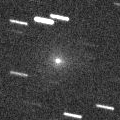
|
Now it is 13.1 mag (June 22, Thomas Lehmann). It will fade out rapidly after this. It stays extremely low. But it will become high in autumn in the Northern Hemisphere. It was expected to brighten up to 11 mag in July. But actually, it is fainter than this ephemeris recently.
Date(TT) R.A. (2000) Decl. Delta r Elong. m1 Best Time(A, h)
July 8 4 29.27 22 33.8 1.536 0.933 36 11.5 3:08 (249, 9)
July 15 5 4.99 22 7.8 1.565 0.931 34 11.3 3:13 (249, 8)
|
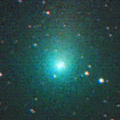
|
It brightened up to 9.5 mag from winter to early spring (Jan. 30, Katsumi Yoshimoto). Now it is 12.0 mag (June 20, Osamu Miyazaki). Fading gradually. In the Northern Hemisphere, it stays observable in good condition. In the Southern Hemisphere, it will be getting higher gradually.
Date(TT) R.A. (2000) Decl. Delta r Elong. m1 Best Time(A, h)
July 8 0 56.33 32 43.8 2.436 2.472 80 11.7 3:08 (261, 55)
July 15 0 52.41 31 35.9 2.367 2.531 87 11.7 3:13 (267, 63)
|
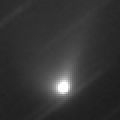
|
It brightened very rapidly as expected. Now it is 11.8 mag (June 17, Osamu Miyazaki). It will fade out rapidly after this. It stays observable in good condition.
Date(TT) R.A. (2000) Decl. Delta r Elong. m1 Best Time(A, h)
July 8 19 49.88 -0 37.7 1.064 2.034 155 12.3 0:49 ( 0, 54)
July 15 19 45.04 0 6.8 1.068 2.047 158 12.4 0:17 ( 0, 55)
|

|
Now it is 13.2 mag (June 18, Hiroshi Abe). It stays 13 mag for a while. In the Northern Hemisphere, it is not observable now, but it will appear in October. In the Southern Hemisphere, it will be getting lower gradually after this, and it will be unobservable in August. But it will be observable again in September.
Date(TT) R.A. (2000) Decl. Delta r Elong. m1 Best Time(A, h)
July 8 10 20.60 -8 14.1 4.196 3.735 56 12.5 21:02 ( 81, -2)
July 15 10 21.36 -9 0.9 4.305 3.751 51 12.6 20:57 ( 83, -7)
|

|
Now it is 12.8 mag (June 19, Chris Wyatt). Fading slowly. In the Northern Hemisphere, it is not observable now. In the Southern Hemisphere, it stays observable in good condition. It was expected to brighten up to 10 mag from spring to summer. However, it is fainter than originally expected.
Date(TT) R.A. (2000) Decl. Delta r Elong. m1 Best Time(A, h)
July 8 12 50.63 -87 45.1 2.597 3.129 112 12.6 21:02 ( 2,-34)
July 15 11 28.13 -85 17.7 2.659 3.142 109 12.7 20:57 ( 6,-34)
|
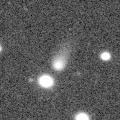
|
It is expected to brighten up to 7 mag in early 2024. Now it is 14.1 mag (June 19, Chris Wyatt). Brightening gradually. In the Northern Hemisphere, it is not observable now. It locates somewhat low in the Southern Hemisphere. But it will become high in winter. The brightness evolution slowed down since May.
Date(TT) R.A. (2000) Decl. Delta r Elong. m1 Best Time(A, h)
July 8 7 11.65 -23 35.8 3.844 3.224 46 13.0 21:02 ( 93,-48)
July 15 7 23.18 -23 49.3 3.778 3.151 45 12.9 3:13 (269,-46)
|

|
It brightened up to 8.3 mag in 2021-2022 winter (Jan. 6, 2022, Toshiyuki Takahashi). Now it is 12.9 mag (June 19, Chris Wyatt). It stays 13 mag for a while. In the Northern Hemisphere, it is not observable now. In the Southern Hemisphere, it will be getting lower gradually. But it will be getting higher again after September.
Date(TT) R.A. (2000) Decl. Delta r Elong. m1 Best Time(A, h)
July 8 9 39.90 -30 15.9 6.261 5.893 64 12.9 21:02 ( 67,-22)
July 15 9 45.26 -30 29.6 6.367 5.938 60 13.0 20:57 ( 69,-25)
|
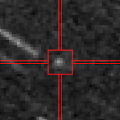
|
It is expected to brighten up to 7.5 mag in October, and it will be observable in excellent condition. Now it is 17.0 mag (June 19, Hiroshi Abe). Brightening rapidly. In the Northern Hemisphere, it stays observable in good condition. It locates somewhat low in the Southern Hemisphere. But it will become high in autumn. It is much fainter than this ephemeris recently. However, Thomas Lehmann reported it is bright as 14.7 mag on June 17. In the Southern Hemisphere, it becomes low temporarily around the high light.
Date(TT) R.A. (2000) Decl. Delta r Elong. m1 Best Time(A, h)
July 8 23 11.02 18 39.5 1.021 1.642 107 13.9 3:08 (316, 69)
July 15 23 25.98 21 34.9 0.924 1.581 108 13.4 3:13 (322, 74)
|
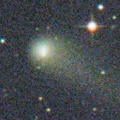
|
It brightened up to 11.1 mag in early 2022 (Mar. 31, 2022, F. Kugel, J.-G. Bosch, J. Nicolas). Now it is 13.1 mag (June 17, Osamu Miyazaki). Fading slowly. In the Northern Hemisphere, it stays observable in good condition. In the Southern Hemisphere, it will be getting lower gradually after this, and it will be unobservable in October.
Date(TT) R.A. (2000) Decl. Delta r Elong. m1 Best Time(A, h)
July 8 15 12.02 21 39.0 4.921 5.321 107 13.5 21:02 ( 45, 72)
July 15 15 12.06 21 25.4 5.037 5.355 102 13.6 20:57 ( 56, 68)
|

|
Now it is 14.3 mag (June 17, Ken-ichi Kadota). Fading slowly. In the Northern Hemisphere, it stays observable in good condition. In the Southern Hemisphere, it will be getting lower gradually after this, and it will be unobservable in September.
Date(TT) R.A. (2000) Decl. Delta r Elong. m1 Best Time(A, h)
July 8 1 58.92 10 41.2 1.687 1.711 73 13.8 3:08 (280, 33)
July 15 2 7.55 14 37.6 1.622 1.714 77 13.8 3:13 (281, 40)
|
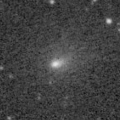
|
Now it is 14.2 mag (June 25, Michael Jager). It will fade out rapidly after this. In the Northern Hemisphere, it stays observable in good condition. In the Southern Hemisphere, it is not observable now, but it will appear in August.
Date(TT) R.A. (2000) Decl. Delta r Elong. m1 Best Time(A, h)
July 8 0 11.75 65 53.6 1.285 1.415 74 14.1 3:08 (201, 54)
July 15 23 27.39 65 15.8 1.152 1.434 82 13.9 3:13 (189, 59)
|

|
Now it is 13.7 mag (June 24, ATLAS South Africa). Fading gradually. It stays observable in good condition.
Date(TT) R.A. (2000) Decl. Delta r Elong. m1 Best Time(A, h)
July 8 16 59.44 -18 45.8 1.516 2.451 150 14.0 21:55 ( 0, 36)
July 15 16 56.97 -18 57.5 1.604 2.492 142 14.2 21:25 ( 0, 36)
|

|
It approached to Earth down to 0.29 a.u. in early February, and it brightened up to 4.5 mag (Feb. 1, Juan Jose Gonzalez). Now it is 13.1 mag (June 10, Chris Wyatt). Fading slowly. In the Northern Hemisphere, it is not observable now, but it will appear in September. In the Southern Hemisphere, it will be getting higher gradually.
Date(TT) R.A. (2000) Decl. Delta r Elong. m1 Best Time(A, h)
July 8 6 10.33 -22 25.7 3.362 2.770 47 14.1 3:08 (273,-37)
July 15 6 15.46 -24 1.9 3.401 2.849 49 14.2 3:13 (279,-32)
|

|
The brightness evolution is slower than originally predicted. Now it is 14.1 mag (June 21, Thomas Lehmann). Fading slowly. In the Northern Hemisphere, it is not observable now. It locates somewhat low in the Southern Hemisphere. But it will become high in winter.
Date(TT) R.A. (2000) Decl. Delta r Elong. m1 Best Time(A, h)
July 8 7 42.38 -39 39.0 2.461 2.191 62 14.2 21:02 ( 67,-47)
July 15 8 7.01 -41 17.9 2.485 2.223 63 14.2 20:57 ( 64,-47)
|

|
Now it is 16.9 mag (June 3, Jean-Francois Soulier). It stays 14 mag for a while. Now it is not observable. It will appear in August.
Date(TT) R.A. (2000) Decl. Delta r Elong. m1 Best Time(A, h)
July 8 7 27.83 24 56.6 7.126 6.115 5 14.2 21:02 (134,-13)
July 15 7 33.61 24 40.8 7.132 6.117 3 14.2 3:13 (224,-16)
|
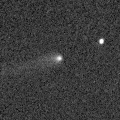
|
Now it is 14.6 mag (June 17, Taras Prystavski). It stays 14 mag for a while. In the Northern Hemisphere, it will be getting higher gradually. In the Southern Hemisphere, it stays observable in good condition.
Date(TT) R.A. (2000) Decl. Delta r Elong. m1 Best Time(A, h)
July 8 2 39.50 5 59.8 3.532 3.258 66 14.4 3:08 (278, 22)
July 15 2 36.57 6 25.8 3.410 3.267 73 14.3 3:13 (283, 29)
|

|
Now it is 14.7 mag (June 13, Jean-Claude Merlin). Fading slowly. It locates somewhat low in the Northern Hemisphere. In the Southern Hemisphere, it stays observable in good condition.
Date(TT) R.A. (2000) Decl. Delta r Elong. m1 Best Time(A, h)
July 8 18 6.81 -26 12.4 1.922 2.919 165 14.5 23:02 ( 0, 29)
July 15 18 2.17 -27 14.7 1.947 2.915 158 14.6 22:30 ( 0, 28)
|
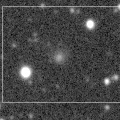
|
Now it is 14.9 mag (July 2, Ken-ichi Kadota). It stays 15 mag for a while. It will be getting lower gradually after this, and it will be unobservable in October. It is expected to brighten up to 12.5 mag in 2024 spring. At the high light, it will be observable in excellent condition in the Southern Hemisphere, but it will be low in the Northern Hemisphere.
Date(TT) R.A. (2000) Decl. Delta r Elong. m1 Best Time(A, h)
July 8 16 8.20 18 53.5 3.077 3.691 119 14.7 21:03 ( 0, 74)
July 15 15 56.49 17 24.9 3.114 3.645 113 14.7 20:57 ( 25, 71)
|
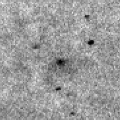
|
Now it is 14.4 mag (June 17, Thomas Lehmann). Fading gradually. It stays observable in good condition.
Date(TT) R.A. (2000) Decl. Delta r Elong. m1 Best Time(A, h)
July 8 1 15.70 -2 49.7 1.944 2.177 88 14.7 3:08 (301, 32)
July 15 1 22.02 -2 28.4 1.900 2.215 93 14.8 3:13 (306, 37)
|

|
It brightened very rapidly. Now it is 14.9 mag (July 6, ATLAS Chile). Fading slowly. In the Northern Hemisphere, it is not observable now. In the Southern Hemisphere, it will be getting lower gradually after this, and it will be unobservable in October. But it will be observable again in July.
Date(TT) R.A. (2000) Decl. Delta r Elong. m1 Best Time(A, h)
July 8 14 46.59 -69 4.9 1.469 2.163 119 15.1 21:02 ( 8,-15)
July 15 14 16.08 -61 24.4 1.513 2.137 113 14.9 20:57 ( 16,-10)
|
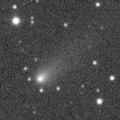
|
Now it is 14.9 mag (June 29, ATLAS Chile). Fading gradually. In the Northern Hemisphere, it will be unobservable in August. In the Southern Hemisphere, it stays observable in good condition.
Date(TT) R.A. (2000) Decl. Delta r Elong. m1 Best Time(A, h)
July 8 13 32.43 -33 35.3 1.926 2.433 107 15.1 21:02 ( 32, 13)
July 15 13 38.48 -33 58.5 2.013 2.445 102 15.2 20:57 ( 35, 10)
|
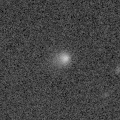
|
Now it is 14.9 mag (June 6, ATLAS Chile). Brightening slowly. In the Northern Hemisphere, it is not observable now, but it will appear in September. In the Southern Hemisphere, it will be unobservable in August. But it will be observable again in September. It is expected to brighten up to 12 mag from 2024 to 2025.
Date(TT) R.A. (2000) Decl. Delta r Elong. m1 Best Time(A, h)
July 8 9 3.97 1 41.6 6.048 5.252 35 15.1 21:02 (100,-12)
July 15 9 6.52 2 3.7 6.070 5.211 29 15.1 20:57 (104,-15)
|

|
The ATLAS search program detected its cometary activity in April. It continues to be brightening even after the perihelion passage. Now it is 15.3 mag (July 5, ATLAS Chile). Fading slowly. It locates somewhat low in the Northern Hemisphere. But it will become high in autumn. In the Southern Hemisphere, it stays observable in good condition.
Date(TT) R.A. (2000) Decl. Delta r Elong. m1 Best Time(A, h)
July 8 23 51.99 -24 28.9 2.189 2.779 115 15.2 3:08 (334, 26)
July 15 23 56.12 -24 46.1 2.142 2.798 120 15.1 3:13 (341, 28)
|

|
It will brighten up to 14 mag from 2024 to 2025. Now it is 15.3 mag (July 4, ATLAS Chile). It stays 15 mag for a while. In the Northern Hemisphere, it is not observable now, but it will appear in October. In the Southern Hemisphere, it will be getting lower gradually. But it will be getting higher again after September.
Date(TT) R.A. (2000) Decl. Delta r Elong. m1 Best Time(A, h)
July 8 9 32.95 -27 4.3 6.378 5.951 60 15.3 21:02 ( 71,-21)
July 15 9 39.19 -26 55.1 6.413 5.923 57 15.3 20:57 ( 73,-25)
|

|
Now it is 15.8 mag (July 4, ATLAS Chile). It stays 15 mag for a while. It stays observable in good condition.
Date(TT) R.A. (2000) Decl. Delta r Elong. m1 Best Time(A, h)
July 8 0 42.87 -4 55.9 3.217 3.495 97 15.3 3:08 (310, 36)
July 15 0 45.74 -4 50.3 3.136 3.510 103 15.3 3:13 (317, 41)
|
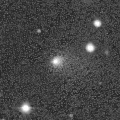
|
It returns for the first time in 70 years. It will brighten up to 4.5 mag in 2024 spring. Now it is 16.3 mag (July 4, Ken-ichi Kadota). Brightening gradually. In the Northern Hemisphere, it stays observable in good condition. In the Southern Hemisphere, it is not observable now, but it will appear in August.
Date(TT) R.A. (2000) Decl. Delta r Elong. m1 Best Time(A, h)
July 8 18 39.48 55 14.8 3.676 4.012 101 16.0 23:33 (180, 70)
July 15 18 27.97 55 40.4 3.612 3.941 101 15.8 22:54 (180, 69)
|
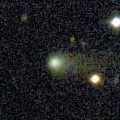
|
Now it is 16.3 mag (June 17, Ken-ichi Kadota). It stays 16 mag for a while. It will be unobservable in August in the Southern Hemisphere, or in September in the Northern Hemisphere. But it will be observable again in October in the Northern Hemisphere.
Date(TT) R.A. (2000) Decl. Delta r Elong. m1 Best Time(A, h)
July 8 10 52.36 22 28.2 4.182 3.643 51 15.9 21:02 (103, 22)
July 15 11 1.25 21 37.4 4.274 3.668 47 16.0 20:57 (104, 19)
|

|
It has not been observed yet in this apparition. It will brighten very rapidly, and it is expected to brighten up to 15 mag in summer. It stays 16 mag for a while. It locates somewhat low in the Northern Hemisphere. In the Southern Hemisphere, it stays observable in good condition.
Date(TT) R.A. (2000) Decl. Delta r Elong. m1 Best Time(A, h)
July 8 16 45.06 -34 46.2 1.280 2.203 146 16.1 21:41 ( 0, 20)
July 15 16 42.41 -33 49.5 1.300 2.181 140 15.9 21:11 ( 0, 21)
|

|
It will approach to Sun down to 0.4 a.u. in late September in 2024, and it is expected to brighten up to 0 mag. Now it is 16.1 mag (June 17, Toshihiko Ikemura, Hirohisa Sato). It stays 16 mag for a while. It will be getting lower gradually after this, and it will be unobservable in October. At the high light, in the Northern Hemisphere, it will be observable in good condition after the perihelion passage. In the Southern Hemisphere, it will be observable in the low sky before and after the perihelion passage.
Date(TT) R.A. (2000) Decl. Delta r Elong. m1 Best Time(A, h)
July 8 14 8.80 2 59.2 5.761 6.074 103 16.1 21:02 ( 47, 48)
July 15 14 6.57 2 45.6 5.809 6.007 96 16.1 20:57 ( 54, 44)
|

|
It brightened up to 13.4 mag in last summer (July 7, 2022, Giuseppe Pappa). Now it is 16.1 mag (July 4, Ken-ichi Kadota). Fading slowly. In the Northern Hemisphere, it stays observable in good condition. In the Southern Hemisphere, it will be unobservable in September.
Date(TT) R.A. (2000) Decl. Delta r Elong. m1 Best Time(A, h)
July 8 15 45.41 34 7.8 3.712 4.108 105 16.2 21:02 ( 79, 86)
July 15 15 38.19 33 57.9 3.839 4.153 100 16.3 20:57 ( 88, 79)
|
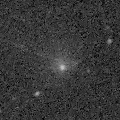
|
Very large comet. It is expected to brighten up to 13 mag in 2031. Now it is 15.9 mag (June 25, Thomas Lehmann). It stays 16 mag for a while. In the Northern Hemisphere, it is not observable now. In the Southern Hemisphere, it stays observable in good condition. In the Northern Hemisphere, it is not observable until 2030.
Date(TT) R.A. (2000) Decl. Delta r Elong. m1 Best Time(A, h)
July 8 3 23.54 -59 5.4 17.383 17.476 93 16.5 3:08 (326,-24)
July 15 3 25.84 -59 28.0 17.322 17.451 95 16.4 3:13 (329,-21)
|
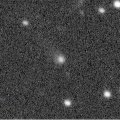
|
Now it is 16.8 mag (June 5, ATLAS Chile). It stays 16 mag for a while. In the Northern Hemisphere, it is not observable now, but it will appear in October. It locates somewhat low in the Southern Hemisphere. But it will become high in autumn.
Date(TT) R.A. (2000) Decl. Delta r Elong. m1 Best Time(A, h)
July 8 8 37.73 -14 53.6 4.446 3.776 43 16.5 21:02 ( 90,-26)
July 15 8 41.76 -15 55.8 4.472 3.765 40 16.5 20:57 ( 91,-31)
|
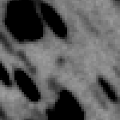
|
Now it is 16.1 mag (June 19, Toshiyuki Takahashi). It stays 17 mag for a while. It stays observable in good condition.
Date(TT) R.A. (2000) Decl. Delta r Elong. m1 Best Time(A, h)
July 8 17 56.36 -10 49.7 1.770 2.746 159 16.7 22:52 ( 0, 44)
July 15 17 51.53 -10 37.5 1.780 2.725 152 16.6 22:19 ( 0, 44)
|

|
Very far object. Now it is 17.0 mag (May 11, ATLAS South Africa). It stays 17 mag for a while. In the Northern Hemisphere, it is not observable now. In the Southern Hemisphere, it stays observable in good condition.
Date(TT) R.A. (2000) Decl. Delta r Elong. m1 Best Time(A, h)
July 8 5 34.98 -67 41.8 10.254 10.337 91 16.8 3:08 (332,-40)
July 15 5 38.28 -68 0.1 10.245 10.334 92 16.8 3:13 (333,-37)
|

|
It brightened up to 14.1 mag in 2022 spring (Mar. 22, 2022, Chris Wyatt). It was expected to brighten up to 13 mag. But actually, it was fainter than originally expected. Now it is 16.6 mag (July 2, ATLAS Chile). It stays 17 mag for a while. In the Northern Hemisphere, it will be getting higher gradually. In the Southern Hemisphere, it stays observable in good condition.
Date(TT) R.A. (2000) Decl. Delta r Elong. m1 Best Time(A, h)
July 8 3 5.98 -3 41.9 5.108 4.755 64 16.9 3:08 (282, 11)
July 15 3 6.65 -3 23.3 5.049 4.800 70 16.9 3:13 (287, 17)
|

|
It approached to Earth down to 0.12 a.u. in April, and brightened up to 11.5 mag (Apr. 8, Osamu Miyazaki). Now it is 15.9 mag (July 3, ATLAS South Africa). Fading gradually. It will be fainter than 18 mag soon. In the Northern Hemisphere, it will be getting higher gradually. In the Southern Hemisphere, it stays observable in good condition.
Date(TT) R.A. (2000) Decl. Delta r Elong. m1 Best Time(A, h)
July 8 2 20.06 -1 31.1 0.928 1.167 73 17.0 3:08 (288, 21)
July 15 2 27.86 -0 48.5 0.952 1.240 78 17.8 3:13 (292, 27)
|
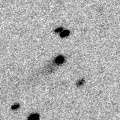
|
Now it is 17.3 mag (June 17, Ken-ichi Kadota). It stays 17 mag for a while. It will be getting lower gradually after this, and it will be unobservable in August in the Southern Hemisphere, or in September in the Northern Hemisphere. But it will be observable again in October in the Northern Hemisphere.
Date(TT) R.A. (2000) Decl. Delta r Elong. m1 Best Time(A, h)
July 8 12 15.49 14 20.8 9.302 9.057 73 17.3 21:02 ( 83, 35)
July 15 12 14.98 14 14.9 9.424 9.067 66 17.3 20:57 ( 87, 30)
|

|
Now it is 16.2 mag (June 10, Michael Jager). Fading rapidly. It will be fainter than 18 mag soon. It stays extremely low in the Northern Hemisphere. In the Southern Hemisphere, it will never be observable after this. In its last apparition in 2014, it was re-observed after 36-year blank.
Date(TT) R.A. (2000) Decl. Delta r Elong. m1 Best Time(A, h)
July 8 5 21.07 25 38.1 1.693 0.871 24 17.3 3:08 (239, 1)
July 15 5 53.87 26 50.7 1.768 0.930 23 18.0 3:13 (238, 2)
|
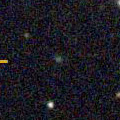
|
Now it is 17.4 mag (Feb. 16, Toshihiko Ikemura, Hirohisa Sato). It stays 17 mag for a while. In the Northern Hemisphere, it will be getting higher gradually. It stays extremely low in the Southern Hemisphere.
Date(TT) R.A. (2000) Decl. Delta r Elong. m1 Best Time(A, h)
July 8 4 16.46 34 52.4 7.551 6.790 38 17.4 3:08 (239, 18)
July 15 4 21.98 35 16.5 7.476 6.782 44 17.4 3:13 (242, 23)
|

|
It is expected to brighten up to 14 mag in winter. Now it is 19.8 mag (June 30, Masayuki Suzuki). Brightening gradually. It stays observable in good condition. It is fainter than this ephemeris recently.
Date(TT) R.A. (2000) Decl. Delta r Elong. m1 Best Time(A, h)
July 8 2 30.29 9 23.1 3.367 3.116 67 17.6 3:08 (276, 26)
July 15 2 38.12 10 3.7 3.242 3.078 71 17.4 3:13 (280, 31)
|

|
It brightened up to 13.6 mag in 2021 (June 17, 2021, R. Carstens). Now it is 17.3 mag (June 9, D. Husar, M. Junius, S. Messner). It stays 18 mag for a while. In the Northern Hemisphere, it will never be observable after this. In the Southern Hemisphere, it will be getting lower gradually.
Date(TT) R.A. (2000) Decl. Delta r Elong. m1 Best Time(A, h)
July 8 10 59.59 -62 58.9 6.572 6.771 96 17.4 21:02 ( 29,-25)
July 15 11 0.44 -62 14.4 6.671 6.805 93 17.5 20:57 ( 31,-27)
|

|
Now it is 17.4 mag (June 17, Toshihiko Ikemura, Hirohisa Sato). It stays 18 mag for a while. In the Northern Hemisphere, it stays observable in good condition. It stays extremely low in the Southern Hemisphere.
Date(TT) R.A. (2000) Decl. Delta r Elong. m1 Best Time(A, h)
July 8 13 35.28 46 12.1 2.935 2.911 78 17.4 21:02 (123, 60)
July 15 13 43.77 44 26.3 2.968 2.905 76 17.5 20:57 (119, 57)
|

|
First return of a new periodic comet which brightened up to 15 mag in 2008. Now it is 18.2 mag (June 16, Toshihiko Ikemura, Hirohisa Sato). It stays 18 mag for a while. In the Northern Hemisphere, it stays observable in good condition.
Date(TT) R.A. (2000) Decl. Delta r Elong. m1 Best Time(A, h)
July 8 2 35.85 22 35.1 2.692 2.387 61 17.5 3:08 (263, 31)
July 15 2 48.04 22 45.3 2.634 2.401 65 17.4 3:13 (265, 36)
|

|
It is expected to brighten up to 14 mag in 2024 summer. At the high light, it is not observable in the Northern Hemisphere. Now it is 18.6 mag (Feb. 16, Toshihiko Ikemura, Hirohisa Sato). Brightening gradually. In the Northern Hemisphere, it will be getting higher gradually. In the Southern Hemisphere, it stays observable in good condition.
Date(TT) R.A. (2000) Decl. Delta r Elong. m1 Best Time(A, h)
July 8 3 15.89 8 51.9 5.079 4.602 56 17.7 3:08 (270, 16)
July 15 3 19.51 8 11.8 4.927 4.551 62 17.5 3:13 (275, 22)
|

|
Now it is 17.8 mag (Feb. 26, Jean-Claude Merlin). It stays 17 mag for a while. In the Northern Hemisphere, it is not observable now, but it will be observable soon. In the Southern Hemisphere, it stays observable in good condition.
Date(TT) R.A. (2000) Decl. Delta r Elong. m1 Best Time(A, h)
July 8 4 30.97 -8 53.6 8.490 7.866 49 17.6 3:08 (274,-10)
July 15 4 34.76 -8 53.3 8.391 7.832 53 17.6 3:13 (278, -4)
|

|
It brightened up to 12.7 mag in last year (Feb. 27, 2022, Jose Guilherme de S. Aguiar). Now it is 17.5 mag (June 16, Toshihiko Ikemura, Hirohisa Sato). Fading gradually. It will be fainter than 18 mag in August. It locates somewhat low in the Northern Hemisphere. In the Southern Hemisphere, it stays observable in good condition.
Date(TT) R.A. (2000) Decl. Delta r Elong. m1 Best Time(A, h)
July 8 19 43.87 -26 41.3 2.132 3.139 170 17.6 0:44 ( 0, 28)
July 15 19 37.67 -26 55.3 2.151 3.165 174 17.7 0:10 ( 0, 28)
|

|
It will brighten up to 16 mag in next winter. Now it is 17.9 mag (June 16, Toshihiko Ikemura, Hirohisa Sato). It stays 17 mag for a while. In the Northern Hemisphere, it will be getting lower gradually after this, and it will be unobservable in September. But it will be observable again in September. In the Southern Hemisphere, it is not observable now.
Date(TT) R.A. (2000) Decl. Delta r Elong. m1 Best Time(A, h)
July 8 11 11.27 56 51.8 2.885 2.459 55 17.7 21:02 (138, 37)
July 15 11 11.03 53 18.1 2.915 2.418 51 17.7 20:57 (135, 33)
|

|
It showed cometary activity in 2023, and brightened rapidly. Now it is 17.4 mag (June 22, ATLAS South Africa). Fading slowly. It will be fainter than 18 mag in August. It stays extremely low in the Northern Hemisphere. In the Southern Hemisphere, it stays observable in good condition.
Date(TT) R.A. (2000) Decl. Delta r Elong. m1 Best Time(A, h)
July 8 14 18.43 -40 2.2 2.840 3.433 117 17.7 21:02 ( 20, 11)
July 15 14 21.76 -39 18.8 2.922 3.439 112 17.8 20:57 ( 24, 10)
|

|
It will brighten rapidly after this, and will brighten up to 7.5 mag in October. Now it is 17.9 mag (June 25, A. Hale). It will brighten rapidly after this. It will be unobservable in September in the Southern Hemisphere, or in October in the Northern Hemisphere. But it will be observable again in July in the Northern Hemisphere. In the Northern Hemisphere, it stays observable in good condition until the high light in mid October. In the Southern Hemisphere, it is not observable at the high light.
Date(TT) R.A. (2000) Decl. Delta r Elong. m1 Best Time(A, h)
July 8 2 48.66 23 26.7 2.189 1.876 58 18.3 3:08 (260, 29)
July 15 3 4.52 24 55.5 2.041 1.795 61 17.7 3:13 (261, 33)
|
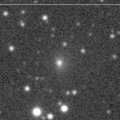
|
It brightened rapidly up to 14.3 mag in April (Apr. 17, Hidetaka Sato). Now it is 17.7 mag (July 1, Observatoire SADR, Poroto). It will fade out rapidly after this. It stays observable in good condition.
Date(TT) R.A. (2000) Decl. Delta r Elong. m1 Best Time(A, h)
July 8 13 50.53 2 38.1 1.916 2.308 99 17.7 21:02 ( 51, 45)
July 15 13 59.86 2 58.6 2.053 2.364 94 18.1 20:57 ( 55, 43)
|
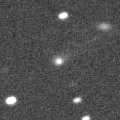
|
It brightened up to 15.9 mag in 2022 spring (May 5, Toshiyuki Takahashi). Now it is 17.1 mag (June 17, Toshiyuki Takahashi). It stays 18 mag for a while. It locates somewhat low in the Northern Hemisphere. In the Southern Hemisphere, it stays observable in good condition.
Date(TT) R.A. (2000) Decl. Delta r Elong. m1 Best Time(A, h)
July 8 15 53.16 -23 43.0 4.216 4.995 135 17.8 21:02 ( 3, 31)
July 15 15 51.95 -23 38.2 4.303 5.003 128 17.9 20:57 ( 10, 31)
|

|
Now it is 17.4 mag (June 29, ATLAS-HKO, Haleakala). It stays 18 mag for a while. In the Northern Hemisphere, it stays observable in good condition. In the Southern Hemisphere, it will never be observable after this.
Date(TT) R.A. (2000) Decl. Delta r Elong. m1 Best Time(A, h)
July 8 15 15.27 79 23.0 10.324 10.080 73 17.8 21:02 (176, 45)
July 15 15 2.96 78 53.8 10.352 10.099 72 17.9 20:57 (174, 45)
|
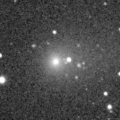
|
It brightened up to 12.4 mag in winter (Feb. 10, Taras Prystavski). Now it is 17.8 mag (June 17, Ken-ichi Kadota). Fading gradually. It stays extremely low in the Northern Hemisphere. It locates somewhat low in the Southern Hemisphere.
Date(TT) R.A. (2000) Decl. Delta r Elong. m1 Best Time(A, h)
July 8 11 1.30 12 14.8 2.967 2.553 56 17.9 21:02 ( 92, 18)
July 15 11 12.19 11 12.3 3.069 2.586 52 18.1 20:57 ( 93, 15)
|

|
It stays 18 mag for a while. In the Northern Hemisphere, it will be getting higher gradually. In the Southern Hemisphere, it stays observable in good condition.
Date(TT) R.A. (2000) Decl. Delta r Elong. m1 Best Time(A, h)
July 8 2 53.90 8 9.7 3.292 2.957 62 17.9 3:08 (274, 20)
July 15 3 2.83 8 29.3 3.217 2.963 66 17.9 3:13 (277, 25)
|

|
It was predicted to brighten up to 16 mag in 2023. But actually, it is very faint as 18.8 mag (June 26, Jean-Claude Merlin). Fading slowly. In the Northern Hemisphere, it is not observable now. In the Southern Hemisphere, it stays observable in good condition.
Date(TT) R.A. (2000) Decl. Delta r Elong. m1 Best Time(A, h)
July 8 19 18.64 -76 7.4 2.829 3.528 126 18.3 0:21 ( 0,-21)
July 15 19 1.20 -74 55.5 2.854 3.555 126 18.4 23:30 ( 0,-20)
|
|
![]()
 77P/Longmore
77P/Longmore C/2022 E2 ( ATLAS )
C/2022 E2 ( ATLAS ) C/2022 JK5 ( PanSTARRS )
C/2022 JK5 ( PanSTARRS ) C/2021 G2 ( ATLAS )
C/2021 G2 ( ATLAS ) 117P/Helin-Roman-Alu 1
117P/Helin-Roman-Alu 1 12P/Pons-Brooks
12P/Pons-Brooks C/2020 S4 ( PanSTARRS )
C/2020 S4 ( PanSTARRS ) 213P/Van Ness
213P/Van Ness C/2023 A3 ( Tsuchinshan-ATLAS )
C/2023 A3 ( Tsuchinshan-ATLAS ) C/2020 R7 ( ATLAS )
C/2020 R7 ( ATLAS ) C/2014 UN271 ( Bernardinelli-Bernstein )
C/2014 UN271 ( Bernardinelli-Bernstein ) C/2022 A3 ( Lemmon-ATLAS )
C/2022 A3 ( Lemmon-ATLAS ) 219P/LINEAR
219P/LINEAR C/2019 E3 ( ATLAS )
C/2019 E3 ( ATLAS ) C/2020 Y2 ( ATLAS )
C/2020 Y2 ( ATLAS ) 364P/PanSTARRS
364P/PanSTARRS C/2020 F2 ( ATLAS )
C/2020 F2 ( ATLAS ) 72P/Denning-Fujikawa
72P/Denning-Fujikawa C/2021 S4 ( Tsuchinshan )
C/2021 S4 ( Tsuchinshan ) 32P/Comas Sola
32P/Comas Sola C/2018 U1 ( Lemmon )
C/2018 U1 ( Lemmon ) C/2022 U4 ( Bok )
C/2022 U4 ( Bok ) P/2023 L1 ( Hill )
P/2023 L1 ( Hill ) C/2022 S4 ( Lemmon )
C/2022 S4 ( Lemmon ) C/2022 QE78 ( ATLAS )
C/2022 QE78 ( ATLAS ) 116P/Wild 4
116P/Wild 4 C/2022 V2 ( Lemmon )
C/2022 V2 ( Lemmon ) P/2014 OL465 ( PanSTARRS )
P/2014 OL465 ( PanSTARRS ) 2P/Encke
2P/Encke C/2023 B2 ( ATLAS )
C/2023 B2 ( ATLAS ) 99P/Kowal 1
99P/Kowal 1 C/2019 O3 ( Palomar )
C/2019 O3 ( Palomar ) 118P/Shoemaker-Levy 4
118P/Shoemaker-Levy 4 170P/Christensen
170P/Christensen C/2021 C5 ( PanSTARRS )
C/2021 C5 ( PanSTARRS )![]()




















































